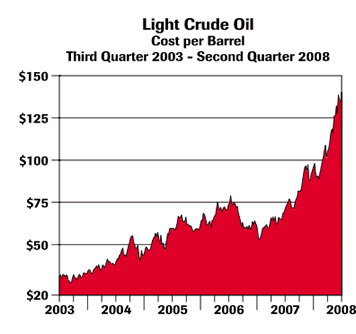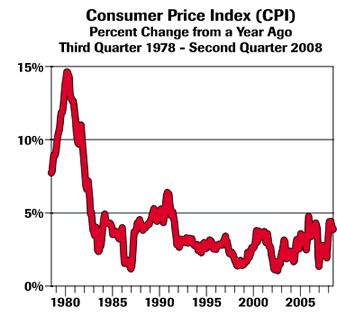2008 Q2 | Market Turmoil Continues
 It was another disappointing quarter for the financial markets as investors remained cautious in the face of high energy prices and continued weakness in the housing market. Uncertainty regarding the Federal Reserve’s course of action in dealing with the economic weakness and credit market issues has also constrained investors. For the quarter, the Dow Jones Industrial Average was off 6.9% following a decline of 6.8% in the first quarter, bringing the year-to-date decline to 13.3%. The month of June was the worst June since 1930, as the Dow was off 10.0%. The S&P 500 was down 11.9% in the first-half. Other indices reported similar first-half results, with the NASDAQ down 13.5% and the Russell 2000, an index of small capitalization companies, off 10.0%. Stock prices tumbled in the quarter due to an especially poor performance by the financial sector. Although J.P. Morgan Chase successfully completed its merger with the failing Bear Stearns, continued problems remain in the sector. The rescue of Bear Stearns was necessary because its business model was not adequately diversified, as it was dependent primarily on sub-prime mortgages and newer “experimental” derivative products, such as credit default instruments.
It was another disappointing quarter for the financial markets as investors remained cautious in the face of high energy prices and continued weakness in the housing market. Uncertainty regarding the Federal Reserve’s course of action in dealing with the economic weakness and credit market issues has also constrained investors. For the quarter, the Dow Jones Industrial Average was off 6.9% following a decline of 6.8% in the first quarter, bringing the year-to-date decline to 13.3%. The month of June was the worst June since 1930, as the Dow was off 10.0%. The S&P 500 was down 11.9% in the first-half. Other indices reported similar first-half results, with the NASDAQ down 13.5% and the Russell 2000, an index of small capitalization companies, off 10.0%. Stock prices tumbled in the quarter due to an especially poor performance by the financial sector. Although J.P. Morgan Chase successfully completed its merger with the failing Bear Stearns, continued problems remain in the sector. The rescue of Bear Stearns was necessary because its business model was not adequately diversified, as it was dependent primarily on sub-prime mortgages and newer “experimental” derivative products, such as credit default instruments.
It was not much better in the bond market as yields across the U.S. Treasury curve moved higher by about a half percent, driving bond prices down during the quarter. For the year, though, yields are essentially unchanged. The yield on the 10-year Treasury, for example, was 3.94% at the end of the period versus 4.15 % on December 31st.
Topping the list of unforeseen developments was a 40% increase in oil prices, from $101 a barrel in March to a record $140 a barrel at the end of June. There are 42 gallons of oil in a barrel, which means that the price run-up resulted in a $1 per gallon increase at the gas pump, bringing gasoline prices, including state and federal taxes, to just over $4 per gallon. Americans consume 386 million gallons of gasoline per day, so the increase in oil is costing consumers roughly $2.5 billion a week, or over $120 billion a year. Surprisingly, this is just about equal to the $1,200 per household rebate that the federal government made to most taxpayers.
 The run-up in oil prices also adversely affected our balance of trade. The oil import cost negatively impacted the dollar in world currency markets as the relationship of the dollar-to-Euro briefly touched 1.60 from a low of 0.83 in 2000. We are currently importing over 70% of our crude oil needs, and this expense, when calibrated at $140 a barrel, is costing the economy an estimated $500 billion annually, or slightly over 3% of our gross domestic product. Adding in our non-oil trade deficits, largely with China, but importantly with other Asian and European economies, we are importing $750 billion more in goods and services than we are exporting, or approximately 5% of our GDP. This is a dangerous level and could threaten the preferred position of the dollar as the world’s currency reserve. As the world’s reserve currency, the United States has some latitude in dealing with import/export imbalances such as we are currently experiencing. Loss of this flexibility would not be positive for the long-term growth prospects of our economy.
The run-up in oil prices also adversely affected our balance of trade. The oil import cost negatively impacted the dollar in world currency markets as the relationship of the dollar-to-Euro briefly touched 1.60 from a low of 0.83 in 2000. We are currently importing over 70% of our crude oil needs, and this expense, when calibrated at $140 a barrel, is costing the economy an estimated $500 billion annually, or slightly over 3% of our gross domestic product. Adding in our non-oil trade deficits, largely with China, but importantly with other Asian and European economies, we are importing $750 billion more in goods and services than we are exporting, or approximately 5% of our GDP. This is a dangerous level and could threaten the preferred position of the dollar as the world’s currency reserve. As the world’s reserve currency, the United States has some latitude in dealing with import/export imbalances such as we are currently experiencing. Loss of this flexibility would not be positive for the long-term growth prospects of our economy.
High oil prices have taken a particularly heavy toll on the U.S. economy. Specifically, automobile sales fell 25% in June from 2007 levels and for the second quarter alone, auto sales declined 20%. Trucks, SUVs, and gas-guzzlers became virtually unsaleable in the quarter. The large existing stocks of owned vehicles plummeted in trade-in value, further complicating the recovery in the automobile sector. The industry’s lack of hybrid and fuel-efficient cars, which are now in demand by the consumer, is further complicating the automotive sector’s ability to deal with these very high gasoline prices.
On a slightly brighter note, Saudi Arabia moderated its hawkish position on oil prices. The Saudis may have realized the threat to the U.S. dollar could negatively affect world economic stability, thereby threatening Saudi Arabia’s own economic security. In late June, the Saudis announced plans to sharply increase oil output and urged other OPEC members to do the same. Clearly, this is an attempt to bring down prices in recognition of the newly-coined term “demand destruction,” brought on by higher oil prices.
– – – – – – – – – – – – – – – – – – – – – – – – – – – – – – – – – – – – – – – – – –
…a break in commodity prices, including oil, could be the magic elixir to putting a halt to the powerful inflationary forces impacting world economies.
– – – – – – – – – – – – – – – – – – – – – – – – – – – – – – – – – – – – – – – – – –
In addition to the oil woes, hopes for a market recovery in housing failed to materialize as foreclosure rates rose and new housing starts fell below 1 million units for the first time since 1991. Sales of existing houses remained weak, and in certain regions of the country, prices fell between 10 and 25% from their peaks in 2006. Credit standards for home mortgages were tightened, media stories portrayed the housing situation as dire, and the negative reaction of the consumer was clearly reflected in a collapse of consumer confidence, falling to levels not seen since 1980.
The Federal Reserve has little maneuvering room due to conflicting policy issues. Deflationary trends in housing and financial services call for liquidity while inflationary pressures in food, energy, and other imported goods demand tighter monetary policy. Chairman Bernanke appears to be caught between the clashing demands. Further Fed easing is really no longer an option as world inflationary trends are pressuring foreign central banks to raise rates, which in turn will prohibit further cuts by the U.S. central bank.
Yet there are some reasons for optimism. First, commercial real estate still appears stable, and sooner or later, pent-up residential demand will cause a recovery in the private housing sector. Second, employment levels remain relatively strong and, real disposable income, as well as U.S. savings rates, are rising. The savings rate, in fact, is now up to a level of 5% of income, higher than at any time since 2002. Additionally, economic growth is likely to have continued in the second quarter, albeit at a slow pace of 1% or less. The long-awaited recession has not yet materialized, although growing imbalances in the economic system could trigger an official recession (defined as two consecutive quarters of negative growth) late in 2008.
The equity markets have now fallen to levels not seen since September of 2006, and we feel that valuations have become very attractive both fundamentally and technically. The current consensus 2008 earnings estimate for the Dow Jones Industrial Average is $865, or 13.2 times forecasted earnings. In 2009, another significant profit gain is anticipated to $1,042 or 11 times currently projected earnings. Historically, these multiples of earnings have proven to be attractive valuations. During the week ended June 27, 2008, 854 companies out of the 3,600 listed on the NYSE set new 52-week lows. Our studies indicate, when lows exceed 600 companies in a given week, the market is significantly oversold; suggesting a short-term rally is possible. This has also been true when the headlines have been particularly negative, as they are now. Investor panic, as evidenced by a very sharp one- or two-day decline would flush out the weak-kneed investors, setting the stage for a true recovery in equity prices.
 In our last several letters, we have been anticipating a year-end Dow of 14,500. Clearly, the economic conditions have not developed as favorably as we expected because of the surprising upward move in energy prices. It is unlikely that 2008 will achieve the high-end of our estimates for share prices. Nevertheless, our optimism for equity prices remains intact and we believe that in the long-term, the growing stream of corporate earnings will eventually be recognized in the form of higher share prices.
In our last several letters, we have been anticipating a year-end Dow of 14,500. Clearly, the economic conditions have not developed as favorably as we expected because of the surprising upward move in energy prices. It is unlikely that 2008 will achieve the high-end of our estimates for share prices. Nevertheless, our optimism for equity prices remains intact and we believe that in the long-term, the growing stream of corporate earnings will eventually be recognized in the form of higher share prices.
We will continue monitoring inflation levels. Despite assurances by the Federal Reserve that inflation appears under control, we remain skeptical simply based on our own limited observations of the rising cost of a variety of the goods and services we personally consume. Although the Fed’s policy options include the need to raise interest rates, which have historically placed downward pressure on financial assets including stocks and bonds, we feel that oil prices hold the key to the near-term economic and market performance. There are now early signs that oil prices are slowing the entire world economic growth model. Even Asian economies are indicating a sharp slowdown in projections for growth in the second half of 2008.
If this were to occur, a break in commodity prices, including oil, could be the magic elixir to putting a halt to the powerful inflationary forces impacting world economies. Such a fall in commodities would cool inflationary expectations, restoring flexibility to the central banks, enabling them to stimulate economies, which should lift housing, auto sales, and other high-ticket consumer purchases. Stock market corrections, unfortunately, are a normal part of the investment cycle. As we find ourselves in the midst of a bear market, share prices in many sectors are well below their intrinsic value and offer investors an opportunity to purchase some of the world’s strongest companies at levels that occur only once in a decade. We continue to take advantage of these opportunities to selectively initiate positions in your portfolios where appropriate.
—Jim Hardesty



